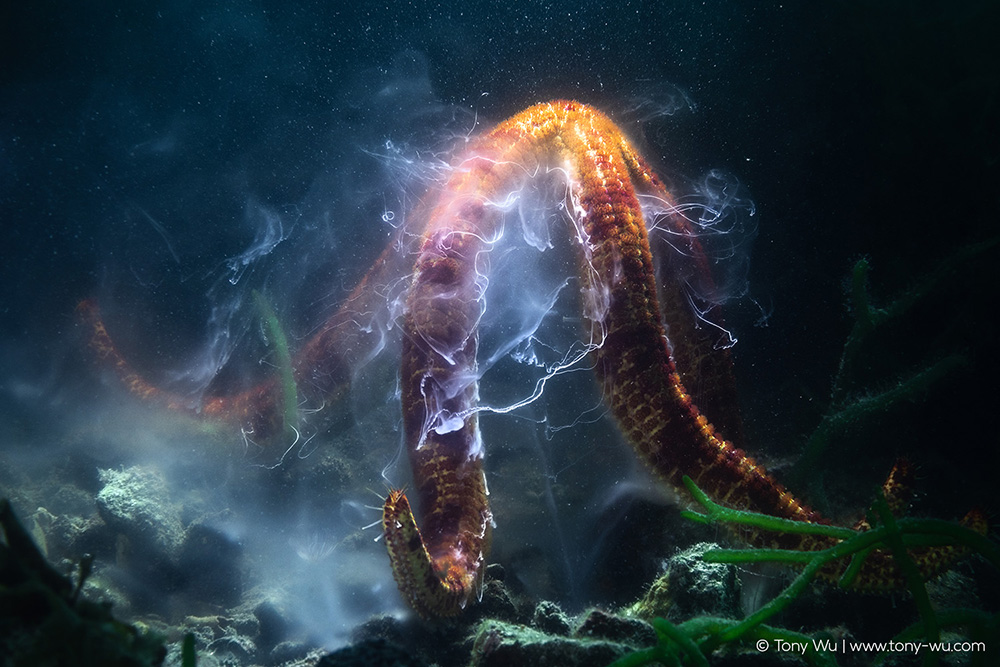July 2021. I was in a brackish bay, mineral-infused water percolating through volcanic rock and mixing with brine. The starry goby (Asterropteryx semipunctata) in front of me was on full display. It was breeding season. I made like a rock in mud, hoping to gain the fish’s acceptance.
That’s when Matsuda-san came charging through the haze. We had only just met several hours earlier, exchanged a few words before submerging. To say that we had much of a relationship at that point would be a stretch.
Eyes wide open, hands gesticulating, he took off, disappeared into the murk. I followed.
And that is how I came to meet this Leach’s sea star (Leiaster leachi):

For the sake of clarity, I will point out that the starfish is male. An excited male. Very excited in fact. So excited that he kept it up for well over an hour. There were peaks and troughs in emissions. Even an exceptionally energetic echinoderm has his limits. (If you require additional explanation, please consult a nearby adult.)
I am happy to share the news that this photograph is the winner of Underwater category in the Wildlife Photographer of the Year contest for 2022 (#WPY58).
I took this photograph in southern Japan, Kagoshima to be exact.
In my view, the waters of Japan are under-appreciated and under-documented. Japan has some of the most rich and diverse marine environments of any nation. From tropical waters in the south to Arctic conditions in the north; the Pacific Ocean to the east, Sea of Japan to the west; and a host of unique environments including the Seto Inland Sea, deepwater trenches, shallow coastal waters, brackish environments, and more.
This makes documenting the aquatic life of Japan both challenging and rewarding. One has to be comfortable with and competent in a wide range of situations, both in the water and on land. The potential reward though, is having the chance to witness behaviour that few have seen and often hasn’t been documented well, if at all.
For this reason, I embarked on a long-term project about eight years ago to study and photograph the waters around Japan. It was slow going at first, more studying than photographing. Whales were keeping me fully occupied.
Then the pandemic happened. I pivoted immediately.
With the exception of the tropical areas, the nutrient-rich oceans around Japan tend to be dark, often characterised by limited visibility. Marine life tends to be drab in order to match surroundings and minimise risk of exposure. At first pass, scenery can appear ho-hum, humdrum, prosaic.
This starfish species, for example, is neither rare nor endangered. It is not charismatic or huggable. These invertebrates are so bland and common that divers almost always ignore them.
A big part of my decision to document marine life in Japanese waters was the desire to draw attention to what I have since dubbed “The Other 99%,” meaning the vast majority of organisms that rarely, if ever, receive attention—from divers, from photographers, from NGOs. From anyone at all.
If you stop to think about it, a few species/ types of animals in any environment receive a disproportionate amount of recognition. In the ocean for instance, sharks, mantas, and whales come to mind. On land, things like tigers, elephants, giraffes.
I have nothing against any of these animals. I love them. The fact that I spent over 20 years concentrating on whales is proof.
But the fact that so much else is often overlooked, almost entirely ignored, has always gnawed at me.
Diving into my Japan project gave me the opportunity to address this feeling, to direct my attention, my efforts, my accumulated experience and knowledge to the challenge of first seeing, then trying to show the beauty in everything, especially that which is considered mundane.
Getting someone’s attention with a photograph of a whale isn’t difficult. Getting people to stop and take notice of a run-of-the-mill echinoderm by contrast, isn’t easy.
For this reason, I am delighted that this starfish has received international recognition. He worked hard for it.
I have since been back to visit Matsuda-san. We are good friends now. The starfish binds us. Upon surfacing that day, it became clear that we share the same love for the pedestrian, the uncelebrated, the other 99%.
I hope that this starfish speaks to you like it did to us.
Its message is this: “There is magic in all life. We just have to pay attention.”
Note: I will be sending out a newsletter soon on the topic of The Other 99%. If you’d like to be on my newsletter mailing list, please sign up here.